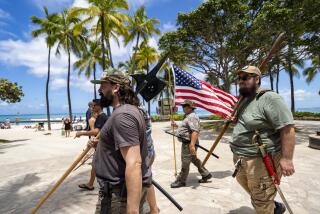Hawaii’s 50th statehood anniversary is a touchy topic
- Share via
From Lori Sablas’ window in the West Maui town of Lahaina, the view has changed almost continuously in the nearly 50 years since Hawaii gained statehood.
In 1959, Sablas was a 16-year-old high school student at Lahainaluna High School. During her youth, she took the obligatory classes in American history, yet she says she learned nothing about events that led to the U.S. annexation of the island chain in 1893.
“I’m from the generation of Hawaiians who weren’t being educated about Hawaiian culture,” she says.
Against that backdrop, the 50th anniversary of statehood won’t be a Disney-style celebration. So far, neither parades nor festivals are planned by the commission overseeing anniversary-related activities. It has, in fact, replaced the word “celebrate” with “commemorate.”
“We want to come across as being respectful of the ongoing issues of the Native Hawaiians,” says Kippen de Alba Chu, the chair of the Statehood Commission. De Alba Chu is not only a native but also the executive director of Iolani Palace, the official residence of the monarchy until it was overthrown.
“We didn’t want to be ‘in your face,’ ” De Alba Chu says of the handful of low-key observances. The highlight -- a conference on Aug. 21, Statehood Day -- will, according to the commission’s website, serve “as a launching pad for discussion about where we want to be in Hawaii’s future.”
For some, the past is a story full of political maneuvering and skulduggery. In 1820, the U.S. government assigned its first representative to Honolulu to look after the “business interests” of the Americans who ran the highly profitable sugar cane plantations. Before long, the islands were abuzz with talk of annexation.
After spending four months in Hawaii, Mark Twain found himself appalled enough to write a sarcastic letter to the New York Tribune, supposedly “supporting” a coup.
“We can make this little bunch of sleepy islands the hottest corner on Earth and array it in the moral splendor of our high and holy civilization,” Twain wrote, tongue in cheek. “Annexation is what the poor islanders need.”
In 1893, a group of Americans led by sugar baron Sanford Dole succeeded in the overthrow of Queen Liliuokalani while politicians in Washington looked the other way.
It took 100 years for Congress to apologize. In a 1993 joint resolution, it acknowledged the illegal seizure of the Kingdom of Hawaii, describing it as “the suppression of the inherent sovereignty of the Native Hawaiian people.”
Sablas, manager of cultural affairs for the Kaanapali Beach Hotel, just a shell’s throw from her birthplace, says she didn’t realize “Hawaii was taken from us until I was an adult.”
“We wanted to be Americans,” she says without bitterness. “Statehood made it legal, like a marriage certificate.”
Some of her fellow kamaaina -- Hawaiian for native -- think a divorce is long overdue.
“I won’t be celebrating the 50th anniversary of statehood. I want to get our country back,” says Henry Noa, who taught school in Honolulu until a few years ago, when he was elected prime minister of the Reinstated Hawaiian Government. The organization seeks secession from the U.S.
Although other nations don’t recognize the legitimacy of Noa’s “government,” he says about 4,500 Hawaiians -- including some non-natives -- have identified themselves as “citizens.” Unable to levy taxes, the organization relies on fundraisers and donations.
“There’s difficulty in financing the building of a nation,” he says. Asked whether his plans for independence are practical, Noa gets emphatic.
“Was it practical for the Jewish people to reclaim Israel?” he asks. “It took them 1,800 years. So what’s 50 years to us?”
Three days after the admission of the 50th state, Pan American became the first airline to offer jet service between the U.S. mainland and Hawaii. The islands, which had been the playground of well-heeled visitors, most of whom traveled by ship, began welcoming middle-class travelers.
In 1960, fewer than 300,000 visitors arrived in Hawaii by plane. But the fields of sugar cane and pineapple quickly gave way to hundreds of beachfront hotels and condos, and by 2006, that annual head count had soared to more than 7.5 million.
Clifford Naeole, the cultural advisor for the Ritz-Carlton Kapalua on Maui, teaches Hawaii’s sometimes-hidden history to guests and his fellow employees.
“One of my most important goals is to get the visitor out of brochure mode and into a sensitive mode,” he says of “A Sense of Place,” the educational program he presents twice a week in the hotel’s amphitheater.
His presentation begins with a screening of the 1996 documentary “Then There Were None,” which explains why many natives now feel like strangers in their own land.
“Don’t measure Hawaiians by how [well] we dance the hula, how pretty our leis are or how good our mai tais taste,” Naeole tells guests. Instead, he wants visitors to understand that “we were philosophers, poets, medicine men and some of the best sailors in the world” long before the arrival of the Americans.
Naeole would vote for independence if he could, he says. But there are also natives who want to keep that 50th star on the U.S. flag.
“I think it [statehood] is a good thing,” says Sablas, the Lahaina-born cultural affairs manager.
“We can’t turn back the clock. But we can continue to be the Hawaiians that we are and to share our heritage with visitors.”
More to Read
Sign up for Essential California
The most important California stories and recommendations in your inbox every morning.
You may occasionally receive promotional content from the Los Angeles Times.










